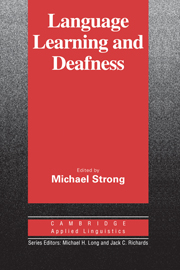Book contents
- Frontmatter
- Contents
- List of contributors
- Series editors' preface
- Preface
- SECTION I THEORETICAL ISSUES
- Chapter 1 Language varieties in the deaf population and their acquisition by children and adults
- Chapter 2 American Sign Language and the human biological capacity for language
- Chapter 3 The history of language use in the education of the Deaf in the United States
- Chapter 4 Sign language instruction and its implications for the Deaf
- Chapter 5 A bilingual approach to the education of young deaf children: ASL and English
- SECTION II RESEARCH REPORTS
- Index
Chapter 2 - American Sign Language and the human biological capacity for language
Published online by Cambridge University Press: 05 October 2012
- Frontmatter
- Contents
- List of contributors
- Series editors' preface
- Preface
- SECTION I THEORETICAL ISSUES
- Chapter 1 Language varieties in the deaf population and their acquisition by children and adults
- Chapter 2 American Sign Language and the human biological capacity for language
- Chapter 3 The history of language use in the education of the Deaf in the United States
- Chapter 4 Sign language instruction and its implications for the Deaf
- Chapter 5 A bilingual approach to the education of young deaf children: ASL and English
- SECTION II RESEARCH REPORTS
- Index
Summary
Editor's introduction
In Chapter 2 Gee and Goodhart discuss the structure and acquisition of ASL in the light of the nativization/denativization hypothesis, arguing forcefully that the study of ASL improves our understanding of the innate aspects of human language, and, indeed, of the nativization hypothesis itself. They carefully explain, primarily through a morphological comparison, why ASL looks like a Creole in some ways but not in others and how it can manifest itself in different forms. The authors then hypothesize that ASL derives from a locative/directional system, possibly determined by the visual perceptual data base from which the nativization process starts. They suggest that, confronted with Slobin's “four charges” to language (be clear, be humanly processible in ongoing time, be quick and easy, be expressive), users of the manual modality, employing cumbersome large muscles of the body, are forced to convey more information per unit of meaning and thus incline to a nonisolating morphology.
This argument is in line with studies that have shown that deaf children exposed to manual forms of English but not to ASL tend to innovate ASL-like forms, even with little or no input in that language. This movement toward ASL-like forms is explained by the innate linguistic biological capacity present in humans using the manual modality. In synthesizing ideas from the nativization hypothesis, pidgin and Creole theorists, and Slobin's cognitive prerequisites of language, Gee and Goodhart have put forth an effectively reasoned explanation for the state of ASL and its varying manifestations among deaf subgroups.
- Type
- Chapter
- Information
- Language Learning and Deafness , pp. 49 - 74Publisher: Cambridge University PressPrint publication year: 1988
- 15
- Cited by



